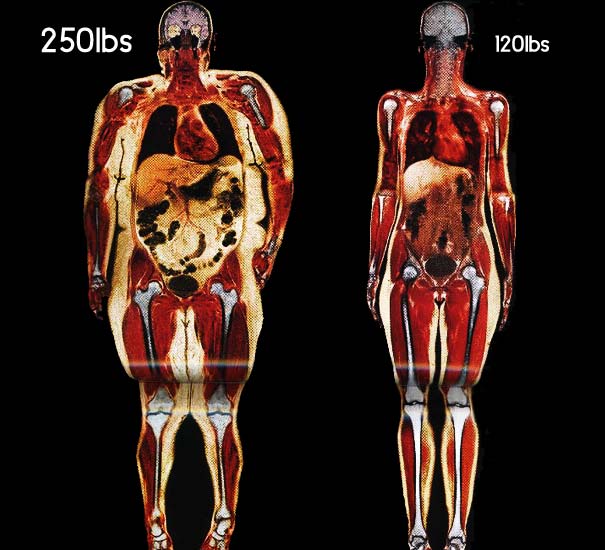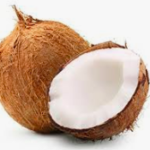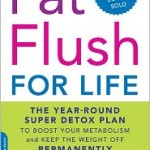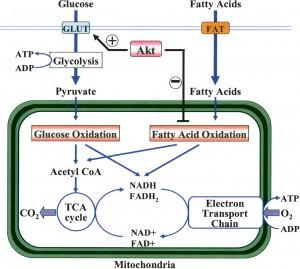250 pound vs. 120 pound woman X-ray
Here is an image to help us strive to be healthier
I don’t think the x-ray is of the same person but I thought this was interesting.
How is the fat distributed in the two different body types shown in that picture? Here is the answer, in the form of images comparing a 120 pound woman with a 250 pound woman:
250 pound vs. 120 pound woman
The light yellow areas are fat. Note especially the huge deposits of fat in the abdomen around the internal organs in the 250 pound woman, as well as all the subcutaneous fat (just under the skin) . The black areas in many cases are air or gas spaces – note the lungs. Or liquid filled, as in the bladder. Note also the heart in the middle of the chest.
The white areas are bone. In descriptions people have asked why the 250 pound woman has what appear to be thinner leg bones. This apparently in an artifact of the slice chosen for the image. Imagine that she is lying down and we take a slice out of the middle of her body. That is what we are seeing. The slice went through thicker bone in the 120 pound woman.
Also notice the ankles of the 250 pound woman. Heavy people often have pronation problems because of the stress of the extra weight on the feet
Glycemic Index And Your Quick Weight Loss
I feel once you are adding food back into your plan after HCG using the Glycemic Index can help
Glycemic Index And Your Quick Weight Loss
by Kevin DiDonato MS, CSCS, CES
Diabetics learned long ago the secret to maintaining a healthy blood sugar. Monitoring the glycemic index, exercise, and medications can help to maintain a healthy blood sugar. Fitness enthusiasts are now starting to delve a little more into the wonderful world of stable blood sugar as a way to lose weight without yo-yo dieting, which can cause mood swings and other things.
People are not resorting to medications, but are using the glycemic index and glycemic load of food as a way to balance not only their diet, but also their blood sugar.
Everyday people, bodybuilders, and athletes are turning more to the glycemic index of food and the new science of nutrition timing as ways to boost weight loss results and athletic performance. The proper timeframes for the body to process nutrients and balancing the amount of carbohydrates, proteins, and fat will help with optimal results.
Even with nutrition timing, glycemic load, and glycemic index, there is still a large amount of confusion as to what each one is and how they affect the body.
Glycemic Index:
The End of Diabetes: The Eat to Live Plan to Prevent and Reverse Diabetes
When we eat carbohydrates, there is a rise in blood sugar. This rise is also associated with the pancreas reacting, causing a release of insulin in the blood stream to shuttle that sugar into the working muscles. This response of the body is automated depending on how much sugar is in the blood. This is where the glycemic index comes in. Carbohydrates are categorized according to how fast or slow the blood sugar rises in the body.

Foods rich in carbohydrates usually have an associated tag with them, which is the glycemic index. There are three indexes that are classified in the index: High, Medium, and Low. High indexed foods will digest quickly and have a fast absorption rate, leading to a sharp rise in blood sugar and resulting in a dual response of the pancreas, releasing a large amount of insulin.
On the opposite spectrum, a food classified as a low-glycemic indexed food will digest and absorb slower, resulting in a much slower rise in blood sugar, resulting in a slower release of insulin in the body. This concept was originally developed as a way to help diabetic patients monitor the types of foods that they were eating, and maintaining a more stable blood sugar response.
Glycemic Load
You may hear the terms glycemic load and glycemic index used in the same sentence. The glycemic load of food utilizes the glycemic index and the portion of carbohydrates to determine how the body will react.
For example, you take in a food that is high in the glycemic index, but a small portion of that. There would be a subsequent release in the blood of sugar and insulin.
With the glycemic load, you might have the same response to a much bigger portion of a lower glycemic indexed food as you did with the small, high glycemic indexed food.
Low Glycemic Foods and Weight Loss
Maintaining a diet of food with a low glycemic index has been shown beneficial in a number of different areas. In the study by Thomas et al, they determined that a diet rich in foods that have a low glycemic index resulted in higher weight loss, lower BMI, lower total fat mass, and a change in reduction in total and LDL cholesterol.
In a similar study, but one involving overweight children, Spieth et al, concluded that a low glycemic diet helped reduce body weight and body mass index in overweight children. The study involved 107 obese children.
They used a low glycemic indexed diet and a low-fat diet. The results showed that children utilizing a low glycemic indexed diet lost an average of 3kg/m, giving stronger evidence that a low glycemic index diet might be beneficial to weight loss.
Research performed by Radulian et al, showed that low glycemic index diets also helped in rapid weight loss, decreasing in fasting glucose and insulin levels, reduction in triglyceride levels, and improvements in blood pressure.
These studies show some promising results, and more research should be done to continue to validate these alternatives.
References:
Spieth, LE. Harnish, JD. Lenders, CM. Raezer , LB. Pereira, MA. Hangen, SJ. Ludwig, DS. A low-glycemic index diet in the treatment of pediatric obesity. Pediatr Adolesc Med. 20100 Sep: 154(9)947-951.
Thomas D, Elliott EJ, Baur L. Low glycaemic index or low glycaemic load diets for overweight and obesity. Cochrane Database of Systematic Reviews 2007, Issue 3. Art. No.: CD005105. DOI: 10.1002/14651858.CD005105.pub2.
Campbell, B. Glycemic Load Vs. Glycemic Index. Paper. NSCA
Foster-Powell K, Holt S, and Brand-Miller J. International table of glycemic index and glycemic load values: 2002. American Journal of Clinical Nutrition, 76:5 – 56, 2002.
Radulian G, Rusu E, Dragomir A, Posea M. Metabolic effects of low glycaemic index diets. Nutrition Journal, 29;8:5, 2009.
HCG Question of the DAY – What to do to get Started!
Getting Started with HCG
HCG Question of the DAY!
Just checked your videos and website. you really did a great job:) your before wasn’t bad at all but way better healthier after.. good luck
i just started purchase hcg and waiting for my shipping and reading as much as i can while waiting and i have some questions please..
Response – Thank you so much, but being the person with the extra weight trying to hike up the trails – I’m here to say…it was bad, I felt like an “old lady” being pushed up the incline . Loved that my family Loved me no matter what but HATED how that all felt!
Question 1-how do you chose which dose to take daily for injection for a women 42 years old?
Response – I always did a 40 day round using 5000iu HCG ( always injections) if you want to do sub-lingual check out Karen (YT -mamaclok) so she can help. I found my “sweet spot” was 125 ( the usual amount for most)Breakdown chart on this website. Let me know if you need help with navigation to find it .You just need to start at that amount and then adjust depending on your weight and hunger level. All I can say from personal experience is as “tricky” as it is, once you hit the “sweet spot” you know when you have arrived.
Question 2- i know i should stop one day a week but do i stop during my monthly period?
Response – YES – at least during the “heavy flow”. But if you can wait for the entire cycle to be done that is best
Question 3– if you please put in your website what to eat in each phase that will be great help for newbies
Response – I will need to look back at my journal but basically when I am on P2 I am very “plain Jane”.
Unless I am doing a “mini steak day” (once a week) I stick with chicken breast, shrimp, or fish. My “BIG” salad with my mustard dressing (on this website). And I love the shrimp scampi recipe that is here on the website from Shannon (YUMMY)
I also love broiled asparagus . As far as fruit… apples ( baked with stevia and cinnamon) are great on cold evenings. When on HCG are always cold evenings – LOL.. And strawberries with powder stevia sprinkled on them. I don’t care at all for the grissini so I omitted that mid way on my very first round.But thise that keep it as part of their P2 may be less “carb sensitive” – hey you never know…
thank you so much for sharing your success
Response – I appreciate your questions!!! – I hope my answers help!!! =)
HCG Got me to Size 1 – !!!!!!!!! – and size 25 jeans – YAY!!!
HCG got me to a size 1! – That’s right size one aka size 25 in jeans – I can’t believe it myself!!! Thank you GOD, My HCG supporters and HCG! – I’m so excited – I feel like I am living a dream – Thank You!! =) Please don’t forget – before I knew about HCG I was pushing 208 lbs.
Benefits of Coconut Oil – A Possible “friend” of HCG
HCG & Coconut Oil (you know, one of the ingredients in Chocolate Delight) 😉
Today I was asked Why Coconut Oil?
Answer –
The truth about coconut oil is obvious to anyone who has studied the health of those who live in native tropical cultures, where coconut has been a primary dietary staple for thousands of years.
Back in the 1930s, Dr. Weston Price found South Pacific Islanders whose diets were high in coconut to be healthy and trim, despite high dietary fat, and heart disease was virtually non-existent. Similarly, in 1981, researchers studying two Polynesian communities for whom coconut was the primary caloric energy source found them to have excellent cardiovascular health and fitness.
Where were all the clogged arteries and heart attacks from eating all of this “evil” saturated fat?
Obviously, coconut oil was doing nothing to harm the health of these islanders.
It may be surprising for you to learn that the naturally occurring saturated fat in coconut oil is actually good for you and provides a number of profound health benefits, such as:
• Improving your heart health
• Boosting your thyroid.
• Increasing your metabolism.
• Promoting a lean body and weight loss if needed.
• Supporting your immune system.
Coconut oil even benefits your skin when applied topically and has been found to have anti-aging, regenerative effects.
So, what are coconut oil’s secrets to success?
How Coconut Oil Works Wonders in Your Body
Nearly 50 percent of the fat in coconut oil is of a type rarely found in nature called lauric acid, a “miracle” compound because of its unique health promoting properties. Your body converts lauric acid into monolaurin, which has anti-viral, anti-bacterial and anti-protozoa properties.
Coconut oil is also nature’s richest source of medium-chain fatty acids (MCFAs), also called medium-chain triglycerides or MCTs. By contrast, most common vegetable or seed oils are comprised of long chain fatty acids (LCFAs), also known as long-chain triglycerides or LCTs.
LCTs are large molecules, so they are difficult for your body to break down and are predominantly stored as fat.
But MCTs , being smaller, are easily digested and immediately burned by your liver for energy — like carbohydrates, but without the insulin spike. MCTs actually boost your metabolism and help your body use fat for energy, as opposed to storing it, so it can actually help you become leaner.
Back in the 1940s, farmers discovered this effect accidentally when they tried using inexpensive coconut oil to fatten their livestock.
It didn’t work!
Instead, coconut oil made the animals lean, active and hungry.
Coconut oil has actually been shown to help optimize body weight, which can dramatically reduce your risk of developingType 2 diabetes . Besides weight loss, boosting your metabolic rate will improve your energy, accelerate healing and improve your overall immune function.
And several studies have now shown that MCTs can enhance physical or athletic performance.
And finally, as we have already discussed, coconut oil is incredibly good for your heart. The truth is this: it is unsaturated fats that are primarily involved in heart disease and too much sugar and processed foods, not the naturally occurring saturated fats, as you have been led to believe.
Coconut Oil in Your Kitchen
Polyunsaturated fats, which include common vegetable oils such as corn, soy, safflower, sunflower and canola, are absolutely the worst oils to cook with.
Why?
Three primary reasons:
1) Cooking your food in omega-6 vegetable oils produces a variety of very toxic chemicals, as well as forming trans-fats. Frying destroys the antioxidants in oil, actually oxidizing the oil, which causes even worse problems for your body than trans-fats.
2) Most vegetable oils are genetically modified including more than 90 percent of soy, corn and canola oils.
3) Vegetable oils contribute to the overabundance of damaged omega-6 fats in your diet, throwing off your omega 6 to omega 3 ratio. Nearly everyone in Western society consumes far too many omega-6 fats — about 100 times more than a century ago — and insufficient omega 3 fats, which contributes to numerous chronic degenerative diseases.
ACV and MSM Drink Shot – Skin Tightening Benefits and More!
I first explained the MCT Oil and ACV drink shot, but then I really wanted to find an alternative for P2ers. Please watch the video for details =)
Where I buy my MSM Liquid
Herbal Remedies
There is also a serum for the face that I get from there that I LOVE!
Super Skin Serum, Antioxidant Skin Care System with Lipoic Acid, 1 fl oz
Know the Glycemic Index – A Way to Stabilize & Maintain
Many years ago I found out about the Glycemic Index. I also listened to Anne Louis Gittleman speak at a conference. I never forgot how great the information was but obviously didn’t always put this information into practice.
Now while on Maintenance after HCG I am utilizing the Glycemic Index principal.
American Diabetes Association uses the Glycemic Index. And if this is all sounding quite familiar, it’s because big named diet programs are promoting that they are now using the Glycemic Index as though it is something “brand new”. In a post coming soon I will explained what I learned from Anne Louise Gittleman about food additives for low fat foods that actually cause your body to want to hold onto fat.
Below is one of the books Anne Louise Gittleman wrote;
Fat is BIGGER than Muscle
Muscle Weighs More than Fat
When it comes time to incorporate exercise back into your lifestyle you will have changes to adjust to.
This example has always stuck with me and I want to share it with you –
If you used one of those “balance scales”, you know the ones with an area to load items on both sides”
Ok, Let’s say on one side you filled the entire side with a can of whipcream. It would spill over the scale plate before you know it.
Now on the other side add a small piece of filet mignon.
Of course on the filet side there would be extra area to add more to the scale plate (no spill over) But GUESS WHAT???
The whip cream (which represents FAT)
Would still weigh less than the filet mignon (Your lean muscle)
Yet the filet would obviously weigh more than the whip cream.
I hope this gives many of you peace of mind.
Because as we know the more MUSCLE our body’s have to maintain, the more calories it needs to sustain itself.
That is a good thing 😉
Weight Loss , Cholesterol Lowering and Detox Teas Review
There are a few teas that I really like to drink during protocol and when not on protocol.
Three of them are made by Triple Leaf:
Super Slimming
Cholesterid
Detox
I have found the best price on the links I have provided below, simply click on the image.
I have also tried the Ultra Slimming tea from the same maker and I feel both are equal at this point.
A SUPER Cleansing tea (if you get my drift) is made by Edom Labs.
This one is a serious “roto rooter”. Be careful when buying this tea. The first time I tried to purchase online through a yahoo store I never got the product. Now Edom Chiro-clenze is available on Amazon so you can can peace of mind.
Another tea I LOVE is not a cleansing tea but is very tasty and I think helps with appetite and cravings.
Other teas I add with the Edom Tea are:






Recent Comments